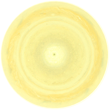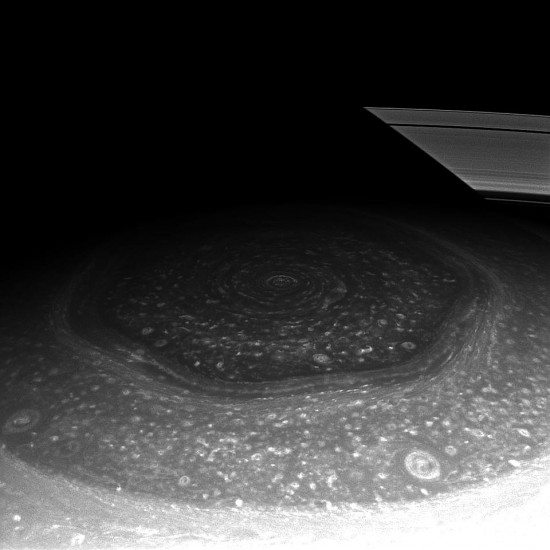Mar 28, 2014
Is the strange polygon at Saturn’s north pole a fluid dynamics phenomenon?
In November 1980, the Voyager 1 spacecraft, now billions of kilometers away from Earth near the Sun’s heliospheric boundary, flew by Saturn. At that time, it recorded an astonishing image, a hexagonal formation in the clouds at the north pole. Saturn’s north pole was tilted away from Earth for many years, preventing ground-based telescopes from obtaining any other images.
On Wednesday, October 15, 1997 a Titan IV-B with a Centaur high-energy upper stage lifted the Cassini spacecraft into Earth orbit in preparation for a multi-year voyage back to Saturn. Cassini entered orbit around Saturn on June 30, 2004. Since then, Cassini took many new images of the Saturnian hexagon, revealing complexities that Voyager was not able to capture. In particular, the concentric ring shapes surrounding the structure and the swirling cloud patterns within it.
Hexagonal and other polygonal shapes are often seen in the eyes of hurricanes, so planetary scientists think that weather patterns on Saturn are responsible for the unusual formation. Several websites recently published laboratory experiments that suggest a fluid dynamics explanation for it. In one experiment, a tank was filled with viscous fluid split into concentric divisions, so that they could be rotated in opposition to each other. As the speed of rotation varied, different features were observed in the liquid. At one point, a hexagon appeared with rotating vortices at each of its sides.
The fluid dynamic experiment seems to provide a plausible description of what is happening on Saturn if several factors are ignored. First, there are concentric rings around the hexagon, each with different temperatures. Second, Saturn’s north and south poles are hotter than theories predict. Third, there are aurorae at the poles. Fourth, there are powerful currents of electric charge entering and leaving Saturn’s poles, connecting it to its family of moons. As previous Picture of the Day articles argue, the plumes of Enceladus, for instance, demonstrate that charge exchange between it and Saturn.
All of these points prove the electrical nature of the Saturnian environment. Simple kinetic experiments, conducted in Earth’s gravity field, are woefully insufficient when the electrical effects are considered. This also leads to another idea: perhaps the polygonal eyes of hurricanes should be reevaluated in the light of electrical theories and not just blowing winds and “Coriolis effect“.
Beams of electricity flowing through plasma produce a central column surrounded by concentric cylinders. The cylindrical filaments create evenly spaced vortices surrounding the column. As the filaments rotate around one another, a preferred hexagonal cross-section forms within the innermost column.
The hexagon at Saturn’s north pole is another example of electrical activity in the Solar System on a tremendous scale. Electricity moves along charged Birkeland current filaments that electrically connect the Sun with its family of planetary bodies. The current energy flows most strongly into the giant gas planets because their charge differential with the Sun is greater than that of their smaller, rocky cousins.
The electric Sun is what drives the energetic meteorological phenomena on Saturn. Electrical circuits power the Sun and initiate the anomalous heating that has been found on Saturn, as well as on the other gas planets.
Stephen Smith
Saturn’s north pole with ring shadows. Credit: NASA/JPL/Space Science Institute.
Jul 01, 2008
Saturn’s Thermogenic Vertex
Once again Electric Universe theorists predicted "mysterious" heat signatures from Saturn’s poles.
In a recent press release, NASA scientists have admitted their surprise at finding a hot north pole on Saturn. Although the northern latitudes of Saturn have been hidden from the sun since 1995 and summer is just beginning, the temperatures are equivalent to those radiated from the south pole. According to Glenn Orton, one of two scientists monitoring the infrared spectrometer onboard the Cassini spacecraft:
"We had speculated that the south pole hot spot was connected to the southern, sunlit conditions. Since the north pole has been deprived of sunlight since the arrival of winter in 1995, we didn't expect to find a similar feature there."
Cassini mission specialists have speculated that the glow from Saturn’s north pole appears to be caused by convection currents carrying heat from warmer southern climes. As Leigh Fletcher, planetary scientist from Oxford University, said:
“The hot spots are the result of air moving polewards, being compressed and heated up as it descends over the poles into the depths of Saturn. The driving forces behind the motion, and indeed the global motion of Saturn's atmosphere, still need to be understood."
Previous Thunderbolts Picture of the Day articles demonstrated that Saturn’s south pole is hotter than can be explained by the relatively dim sunlight that it receives. Because the mechanical view of the anomalies in the south fails to explain the increased temperature there, Electric Universe proponents suggest that another source for the energy input must be considered and that is electricity.
One of the most bizarre configurations discovered on Saturn is the hexagon that dominates its north pole. The formation was originally seen by cameras onboard the twin Voyager spacecraft that flew by Saturn in November 1980 and then again in August 1981. NASA researchers continue to refer to the structure as “unexplained”, since the convective interpretations of Saturnian weather do not include mechanisms by which clouds can organize themselves into polygonal shapes.
For many years researchers studying the issue have known that beams of electricity flowing through plasma produce a central column surrounded by concentric cylinders. The cylindrical current filaments exhibit long-range attraction and short-range repulsion braiding that result in evenly spaced vortices surrounding the column. As the filaments rotate around one another, a preferred hexagonal cross-section forms within the innermost column. Hexagonal craters can be seen etched into the surfaces of planets and moons. Weather patterns, such as hurricanes on Earth, also exhibit hexagonal “eyes” that defy conventional explanation.
The hexagon at Saturn’s north pole is another example of electrical activity in the solar system on a tremendous scale. Electricity moves along Birkeland current filaments that electrically connect the Sun with its family of planetary bodies. The energy flows most strongly into the giant gas planets because their charge differential with the Sun is greater than that of their smaller, rocky cousins.
The “electric Sun” is what drives the energetic meteorological phenomena on Saturn (and the other planets). Electrical circuits power the Sun and initiate the “anomalous heating” that has been found on Saturn, as well as on the other gas planets that have been examined – Jupiterand Neptune display “hot poles” just like Saturn.
Once conventional science sees the question in electrical terms, the many puzzles with which they are confronted will become clear. Such issues as “climate change” on Earth and the “double-eye” vortices on Venus and Saturn will be illuminated. Theories regarding the “hot poles” on Enceladus, Titan and Io will also benefit from acknowledging the principle tenets of the Electric Universe.
By Stephen Smith



